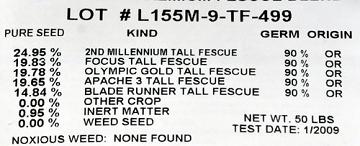For Seeding Success, Pay Attention to “Other Crop” on the Seed Label
Orchardgrass is a problem because it is faster growing and lighter green than our turfgrasses. It is a bunch grass and so doesn’t spread, but infested areas are still unsightly due to small tufts of this species pockmarking the lawn.
Rough bluegrass is fine-textured and forms circular patches in the lawn. It blends in fairly well until summertime heat causes it to turn brown rapidly. If the rough bluegrass would just die in the heat, it would only be a temporary problem. Unfortunately, it usually just goes dormant, turning green again with cooler temperatures and rain.
Buying quality seed starts with knowing how to decipher the seed label. One of the most important things to look for is listed as “% other crop.” “Other crop” refers to any species that is intentionally grown for some purpose. That would include turfgrasses (those species other than the one you are buying) and pasture grasses. Orchardgrass and rough bluegrass both are listed as “other crop” seed. Seed labels are required by law to show the percentage (by weight) of “other crop” in the bag, but unless a species constitutes 5% or more, the label doesn’t have to list each species by name.
<span “font-size:12.0pt;mso-bidi-font-size:10.0pt;font-family:”times=”” roman”,”serif”;=”” mso-fareast-font-family:”times=”” roman”;color:black;mso-ansi-language:en-us;=”” mso-fareast-language:en-us;mso-bidi-language:ar-sa”=””>How much “other crop” is too much? That’s a difficult question to answer, but the tolerance is very low. It depends on what the “other crop” actually is, and the quality expectations of the buyer. In practice, “other crop” may refer to something relatively harmless, like a small amount of perennial ryegrass in a bag of tall fescue, or it may refer to something bad, like rough bluegrass or orchardgrass. The homeowner really has no easy way of knowing what the “other crop” is, although there are some hints. If it is something bad, less than ½ of 1% can ruin a bag of seed. Obviously, if your expectations are high for the area you are planting, you would want the “other crop” to be as close to zero as possible. Good quality seed will often have 0.01% “other crop” or less.




Leave a Reply
You must be logged in to post a comment.